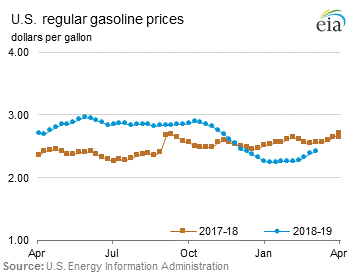
Have you ever noticed that fuel prices tend to drop in the late fall and winter? Were you wondering if it was just in your head that gas prices seemed lower just a few fill-ups ago? It’s not just you!
In typical years, as the nights get longer fuel prices tend to decline until we bottom out sometime in December or January. Now that the nights are getting shorter and the daylight growing? Gas prices have been marching upward, just like they do most years in the springtime.
Of course, it has nothing to do with the length of day or night, but the seasons do play a role. That’s because our gasoline actually changes throughout the year. To try to keep smog levels lower during the summer months, gasoline is blended to be more stable (i.e. evaporate less on hot days). The process and chemicals used to do that makes summertime gasoline more expensive. In winter, the chemical soup we call gasoline is blended differently, which also tends to lower the price.
To be sure, there are other factors at play, such as a big drop in oil prices this past November, which are creeping back up again. According to the March 6th weekly petroleum report by the U.S. Energy Information Administration (EIA), the nationwide average gas price last week was $2.42 per gallon. According to the Minnesota Department of Commerce, gasoline was just $2.04 on average in January. The EIA predicts this year’s gasoline prices will peak at $2.57 in June.
Now is also the time of year for refineries to start changing their refining process to get ready for summer. Often refineries will go offline or slow down to do their annual maintenance at the same time. That results in a lower supply of gasoline. And if you’ve ever had one day in an economics class they teach you that a drop in the supply of anything results in a higher price.
What’s ethanol’s role in pricing?
The short answer: ethanol helps keep prices down. Ethanol is one of the many ingredients mixed together and sold as “gasoline”. Ethanol raises the octane, which would otherwise be done with petroleum-based chemicals like Benzene, Toluene, or Xylene. Not only do those chemicals raise a variety of health concerns (for example, benzene is a known cause of cancer), they also cost more than ethanol and raise the cost of gasoline.
All of Minnesota’s regular grade of 87 octane gasoline contains 10 percent ethanol and has for more than 20 years. Today, more than 300 stations sell an 88 octane gasoline that contains 15 percent ethanol, which typically retails under names like Unleaded88. That extra ethanol is the reason you’ll find the 88 octane button to be lower priced than the 87.
And, of course, if you are lucky enough to be driving a flex fuel vehicle, you can choose to use E85, which typically sells for a much lower price and dramatically reduces the amount of gasoline you use. E85 is available at more than 400 retail locations in Minnesota.
So as our days grow longer and warmer, the snow is melting (hopefully not too fast) and gas prices are rising, but ethanol is working for you to help try to keep those prices in check.
